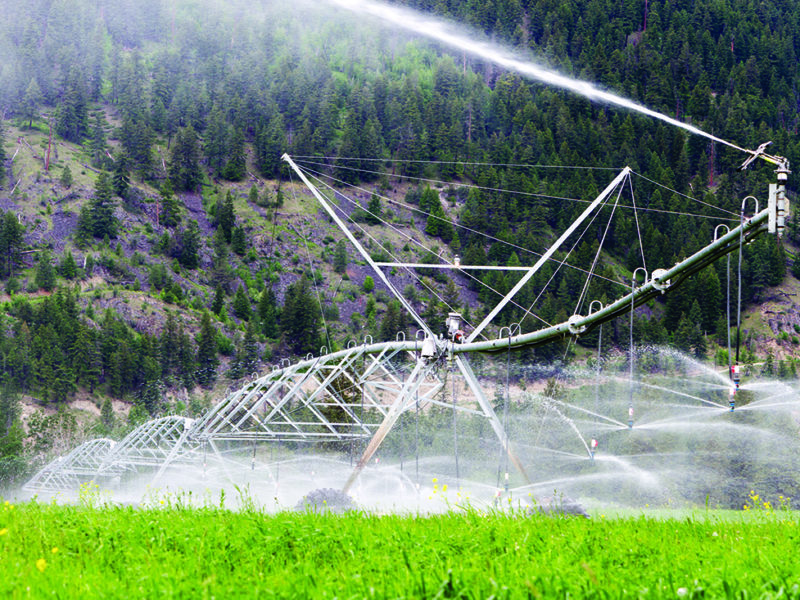VERNON – Winter weather chilled the turnout for the annual North Okanagan Livestock Association educational seminar in Vernon on January 15.
Just half the 80 people registered made it to the event.
“Some of our sponsors were not even able to make it,” says NOLA president Lani French. “The -20 temperatures and the poor road conditions kept people at home.”
Nevertheless, the show went on.
A networking lunch was followed by a screening of the film “Guardians of the Grasslands,” a short documentary on the vital role of cattle in conserving the ecosystem of the Prairies. The region’s grasslands are one of the most endangered ecosystems on earth, even more so than the Amazon rainforest. The film explains the importance of grazing, originally by bison and now by cattle, in sustaining the landscape’s health. It also explained the massive carbon sequestration role the grasslands provide.
While the film was shot in Alberta as a joint project between Ducks Unlimited, the Nature Conservancy of Canada and the Canadian Cattlemen’s Association, French says the message also applies to BC grasslands.
“It’s a powerful film,” she says, tearing up.
Calf survival
Jeanette Perry from White Valley Veterinary Services in Lumby spoke about improving calf survival at birth, drawing on her experience teaching cattle medicine in Australia.
“Birth is a make or break time for cattle,” says Perry. “More than half of calf deaths occur in the first 24 hours.”
Environmental Farm Plan (EFP) regional advisor Pete Spencer gave an update on the program.
“Winter is the best time to get your environmental farm plan done,” he says. “Come April 1, when the program funding opens up, things get pretty crazy.”
Spencer is looking for new and interesting projects to fund this year. He notes there are 60 different areas the program supports.
“You can qualify for up to $70,000 cost-shared funding to improve your ranch sustainability,” he says.
Changes to the criteria for irrigation funding kept Spencer busy this past year.
“They have really opened up the requirements under irrigation,” says Spencer, noting that more commodities will be able to apply this year. “They have changed the awarding of project funding to a merit-based system.”
Applications are assessed on how using less water helps the environment.
“If you are saving water from the Kettle River, for example, you will be considered before someone who gets their water from a purveyor,” he explains.
Pivot irrigation systems have been a popular projects with program participants.
“Even though they are expensive, they save water,” says Spencer. “Pivots are a benefit, particularly when water is becoming more expensive and even running out in some areas.”
He adds that he is looking to work with BC Agriculture and Food Climate Action Initiative staff to develop a cost-benefit analysis for installing pivot systems.
Spencer points out that EFP pays producers for management plan development, including irrigation and nutrient management plans.
AEM Code support
EFP has a new work plan to support the Code of Practice for Agricultural Environmental Management (AEM Code) introduced last year, Spencer says. There is a basic amount of monitoring that is required for all operations that apply nutrients. Three high-risk locations require additional measures – areas with high rainfall, areas over vulnerable aquifers and phosphorus-affected areas.
“I don’t think the new regs are actually all that bad,” says Spencer. “I promote soil sampling anyway and the AEM Code says it must be done every three years.”
A summary document prepared by the BC Cattlemen’s Association is an excellent resource, Spencer notes. (It is available for viewing and download at [http://bit.do/BCCA-AEMCoP].)
The new dam safety plans the province requires can be costly if the dam is of significant size and potential consequence. Spencer recalls a rancher group that applied for EFP funding to assist with the development of a dam safety plan for their jointly owned dam.
“They shared the cost and, with funding, it was nearly free for them,” he says.
Shawn Wilson, a third-generation producer from Alberta, discussed some of the challenges in cattle industry markets as well as tips for a producer to increase the value of their animals at sale time.
“The best way to illustrate the cattle market is to look at a picture of a roller coaster,” says Wilson. “You need to know what works for your ranch program and have a plan.”
French notes there will not be an education seminar in 2021. NOLA will be focusing its energies on hosting the BC Cattlemen’s convention in Vernon.


 New executive director for COABC appointed
New executive director for COABC appointed